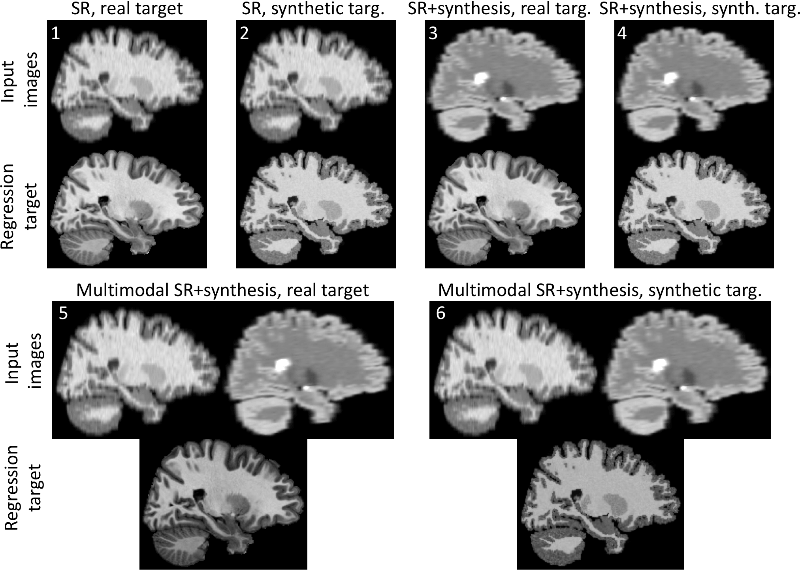SynthSR
This repository contains code to train a Convolutional Neural Network (CNN) for Super-resolution (SR), or joint SR and data synthesis. The method can also be configured to achieve denoising and bias field correction.
The network takes synthetic scans generated on the fly as inputs, and can be trained to regress either real or synthetic target scans. The synthetic scans are obtained by sampling a generative model building on the SynthSeg [1] package, which we really encourage you to have a look at!
In short, synthetic scans are generated at each mini-batch by: 1) randomly selecting a label map among of pool of
training segmentations, 2) spatially deforming it in 3D, 3) sampling a Gaussian Mixture Model (GMM) conditioned on the
deformed label map (see Figure 1 below), and 4) corrupting with a random bias field. This gives us a synthetic scan at
high resolution (HR). We then simulate thick slice spacing by blurring and downsampling it to low resolution (LR).
In SR, we then train a network to learn the mapping between LR data (possibly multimodal, hence the joint synthesis) and
HR synthetic scans. Moreover If real images are available along with the training label maps, we can learn to regress
the real images instead.
Tutorials for Generation and Training
This repository contains code to train your own network for SR or joint SR and synthesis. Because the training function has a lot of options, we provide here some tutorials to familiarise yourself with the different training/generation parameters. We emphasise that we provide example training data along with these scripts: 5 preprocessed publicly available T1 scans at 1mm isotropic resolution [2] with corresponding label maps obtained with FreeSurfer [3]. The tutorials can be found in scripts, and they include:
-
Six generation scripts corresponding to different use cases (see Figure 2 below). We recommend to go through them all, (even if you're only interested in case 1), since we successively introduce different functionalities as we go through.
-
One training script, explaining the main training parameters.
-
One script explaining how to estimate the parameters governing the GMM, in case you wish to train a model on your own data.
 Figure 2: Examples generated by running the tutorials on the provided data [2]. For each use case, we show the synhtetic
images used as inputs to the network, as well as the regression target.
Figure 2: Examples generated by running the tutorials on the provided data [2]. For each use case, we show the synhtetic
images used as inputs to the network, as well as the regression target.
Content
-
SynthSR: this is the main folder containing the generative model and training function:
-
labels_to_image_model.py: builds the generative model.
-
brain_generator.py: contains the class
BrainGenerator, which is a wrapper around the model. New images can simply be generated by instantiating an object of this class, and calling the methodgenerate_image(). -
model_inputs.py: prepares the inputs of the generative model.
-
training.py: contains the function to train the network. All training parameters are explained there.
-
metrics_model.py: contains a Keras model that implements diffrent loss functions.
-
estimate_priors.py: contains functions to estimate the prior distributions of the GMM parameters.
-
-
data: this folder contains the data for the tutorials (T1 scans [2], corresponding FreeSurfer segmentations and some other useful files)
-
script: additionally to the tutorials, we also provide a script to launch trainings from the terminal
-
ext: contains external packages.
Requirements
This code relies on several external packages (already included in \ext):
-
lab2im: contains functions for data augmentation, and a simple version of the generative model, on which we build to build
label_to_image_model[1] -
neuron: contains functions for deforming, and resizing tensors, as well as functions to build the segmentation network [4,5].
-
pytool-lib: library required by the neuron package.
All the other requirements are listed in requirements.txt. We list here the most important dependencies:
- tensorflow-gpu 2.0
- tensorflow_probability 0.8
- keras > 2.0
- cuda 10.0 (required by tensorflow)
- cudnn 7.0
- nibabel
- numpy, scipy, sklearn, tqdm, pillow, matplotlib, ipython, ...
Citation/Contact
This repository contains the code related to a submission that is still under review.
If you have any question regarding the usage of this code, or any suggestions to improve it you can contact us at:
e.iglesias@ucl.ac.uk
References
[1] A Learning Strategy for Contrast-agnostic MRI Segmentation
Benjamin Billot, Douglas N. Greve, Koen Van Leemput, Bruce Fischl, Juan Eugenio Iglesias*, Adrian V. Dalca*
*contributed equally
MIDL 2020
[2] A novel in vivo atlas of human hippocampal subfields usinghigh-resolution 3 T magnetic resonance imaging
J. Winterburn, J. Pruessner, S. Chavez, M. Schira, N. Lobaugh, A. Voineskos, M. Chakravarty
NeuroImage (2013)
[3] FreeSurfer
Bruce Fischl
NeuroImage (2012)
[4] Anatomical Priors in Convolutional Networks for Unsupervised Biomedical Segmentation
Adrian V. Dalca, John Guttag, Mert R. Sabuncu
CVPR 2018
[5] Unsupervised Data Imputation via Variational Inference of Deep Subspaces
Adrian V. Dalca, John Guttag, Mert R. Sabuncu
Arxiv preprint (2019)
